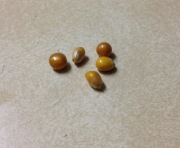Sweet corn season is finally upon us in Central Illinois! Growing up on a farm, I’ve been spoiled with as much sweet corn as I could possibly manage to eat. And the ears picked on the farm are significantly better than what you can buy in the store, something that I’ve learned first-hand now that I am off at college and don’t live at home anymore.

The field corn is the taller corn in the back- it’s about 8 ft or taller. The sweet corn is towards the front and is around 5-6 ft tall.
Some questions I’ve heard before as a presenter include things such as “Why do we grow so much corn in the Midwest?”, “Does your family really eat all of the corn you grow??”, and “Why are we using up all of the corn we eat on things like fuel and plastic?”. Assuming that lots of people have questions along these lines, I’m going to explain the difference between that ear of corn on your plate and what you’ll see farmers harvest come fall over the next few posts. (I have LOTS to say on the subject 🙂 )
There are many types of corn, the main three being popcorn, sweet corn, and field corn.
-
Popcorn is really easy to explain- it’s the stuff you buy at the movie theater or pop in the microwave at home. They are small brown seeds that turn into fluffy goodness once you add a bit of butter and salt (and maybe a few M&Ms.)
- Sweet corn is only grown to eat. You can purchase it fresh on the ear around this time of year, or can find it in the frozen or canned food aisles year-round.
- Field corn (yellow dent #2) is not for direct consumption. Unlike sweet corn, which is harvested before it is mature so that it is sweet, field corn is allowed to grow to full maturity and is starchy. This type of corn is processed and separated into oil, starch, and protein. These are then used as ingredients in other food and non-food products, such as animal feed and ethanol. When you drive through the Midwest, the corn you see growing along the interstate are most likely field corn.

Field Corn (above), Sweet Corn (below); These ears are both at the stage that you would pick and use the corn. The kernels on the field corn each have a small dent, which indicates that the moisture is no longer present (most farmers harvest corn at 15% moisture). The sweet corn is immature, so it is still in the “milk” stage and is juicy and sweet. If you let sweet corn go all the way to maturity, the kernels would be dried and wrinkly.
So to answer the questions I listed at the beginning of the post….
Why do we grow so much corn in the Midwest?
We grow lots of corn in the Midwest because we have a great climate to produce corn. Fertile soil, combined with a humid summer and temperatures that are not quite too hot (most of the time) nor too cool, and an ideal rainfall contribute to higher than national average yields. Put in a rotation with soybeans or wheat, farmers are able to replace nutrients and head off certain types of insects, weeds, and diseases. Many farmers in the Midwest choose to grow corn over other crops, such as tomatoes (which also grow pretty well in these conditions), because corn will fetch a higher price at market and is much less labor-intensive. Tomatoes are more well-suited in other parts of the United States, such as Michigan or California. (You can check out my post on Keeping it Local to find out more on why certain foods are grown in different places).
Does your family really eat all of the corn you grow?
Well, we mostly grow field corn, which is then taken to the grain elevator in town and sold on the market. Some farmers store their grain on their farm, but it works out better for us to take it to the elevator to store. Since we grow field corn, we do not eat it directly from our farm, but it is possible we could encounter it in foods and other products we purchase from the store, or in the fuel we put in our vehicles. We do plant a small amount of sweet corn, but that is just for us to have some to eat and some to share during the summer.
Why are we using up all of the corn we eat on things like fuel and plastic?
You could probably answer part of that question now that you are such an expert in identifying different kinds of corn. 🙂 We use field corn (not sweet corn or popcorn) on non-food items, as well as several food items. Corn is a great renewable resource grown right here in the United States, and it just makes sense to utilize this resource. Of course, as with anything, there is controversy surrounding it. I’ll use the next couple of posts to explain what the field corn is used for and to present some of the myths and arguments made against it’s use.
As always, feel free to comment or tweet me with questions. Please remember that everyone is entitiled to their own opinion (that’s one of the many perks of being an American), so keep an open mind about future topics I present to you.


4 Comments
A Farm Kid's Guide to Agriculture | WRDA Rundown
May 23, 2014 at 10:08 am[…] you know the Midwest is full of corn, AKA- “corn country”. And you know from some of my previous posts that we cannot possibly consume all of the corn we grow in the Midwest, nor would we necessarily […]
A Farm Kid's Guide to Agriculture | WRDA Rundown
May 23, 2014 at 10:08 am[…] you know the Midwest is full of corn, AKA- “corn country”. And you know from some of my previous posts that we cannot possibly consume all of the corn we grow in the Midwest, nor would we necessarily […]
WRDA Rundown | A Farm Kid's Guide to Agriculture
September 26, 2014 at 3:44 pm[…] you know the Midwest is full of corn, AKA- “corn country”. And you know from some of my previous posts that we cannot possibly consume all of the corn we grow in the Midwest, nor would we necessarily […]
WRDA Rundown | A Farm Kid's Guide to Agriculture
September 26, 2014 at 3:44 pm[…] you know the Midwest is full of corn, AKA- “corn country”. And you know from some of my previous posts that we cannot possibly consume all of the corn we grow in the Midwest, nor would we necessarily […]